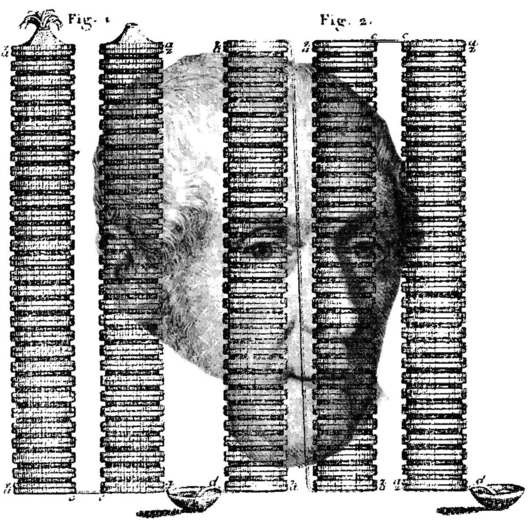Alessandro Volta1745–1827
Volta is shown in his diagram of a battery that will deliver a constant current. He was initially enthusiastic about Galvani's experiments but later criticised the hypothesis of animal electricity. He wrote in 1792: "Galvani's discovery is going to be most fertile of very useful applications in both theoretical and practical medicine". Volta had a particular interest in the effects of electrical discharges on the different senses. He carried out studies of galvanic light figures in the 1790s, and also found that intermittent electric stimulation was usually more effective in stimulating motor nerves and many sensory nerves than constant stimulation. In his letter describing the pile or battery,Volta (1800) described how with an appropriate positioning of the stimulating electrodes he could produce the corresponding sensation by stimulating the eyes, ears, nose, and tongue at once all together and also produce pain and movement in the lips. He was particularly skilful in producing light sensation by connecting the wires from a battery (or also simply a bimetallic arc) between the mouth and conjunctiva of the eye, which resulted in the experience of light, particularly in a dark room. Moreover, he noted that the visual sensation was associated with the onset and offset of the current, and a continuous impression of light could be produced by rapid alternation of polarity. In his study of pain sensation induced by electric stimuli Volta was able to distinguishing two types of pain, one of more rapid onset and of more acute and pricking character (a piqûre in the original French) and a second one of slower onset and of a burning quality (a cuisson). These correspond to the two classes of pain sensations that we now know to be carried respectively by fast, myelinated nerve fibres, and slow, unmyelinic fibres. On the basis of his experiments Volta concluded that the effect of nerve stimulation depended on the type of nerve fibre stimulated and not on the nature of the stimulus, thus partly anticipating the law of the "specific nervous energies" later formulated by Johannes Müller. He wrote (in 1792): "It, therefore, becomes manifest that according to which nerve is stimulated and to what is its natural function, such is the effect that ensues correspondingly, that is to say as regards sensation and motion, when that nervous virtue is activated on subjecting it to the influx of electrical fluid". Volta showed an extraordinary capability of obtaining physical and physiological measurement on the basis of his sensory perception and the ingenuous experimental contrivances he invented. On the basis of the intensity of the gustatory sensation perception he was able to define an accurate scale of the efficacy of different metals in producing electricity when connected to a reference one. Moreover, having demonstrated that a temporal summation occurred when electric stimuli of different durations were applied to the skin in order to produce muscle contraction, he arrived at an evaluation of the time constant of the summation process which correspond in an astonishing way to the modern measurements (amounting to a little less of 20 milliseconds). This he achieved with clocks which could only resolve time intervals of 1 second! As for the practical medical applications he suggested for instance that electricity could be useful not only in therapy (according to the principles of electrical medicine) but also as a diagnostic tool. Having demonstrated the possibility of producing a light sensation by electrical stimulation of the eye, he suggested that this type of stimulation could be used to differentiate a condition of blindness due to dysfunction of the optic nerve (where no light sensation would be produced), from one of opacity of optical media (cataract) in which the electric stimulus would be effective. In some cases Volta also applied electricity for therapeutic purposes, having some success particularly with a deaf patient.
